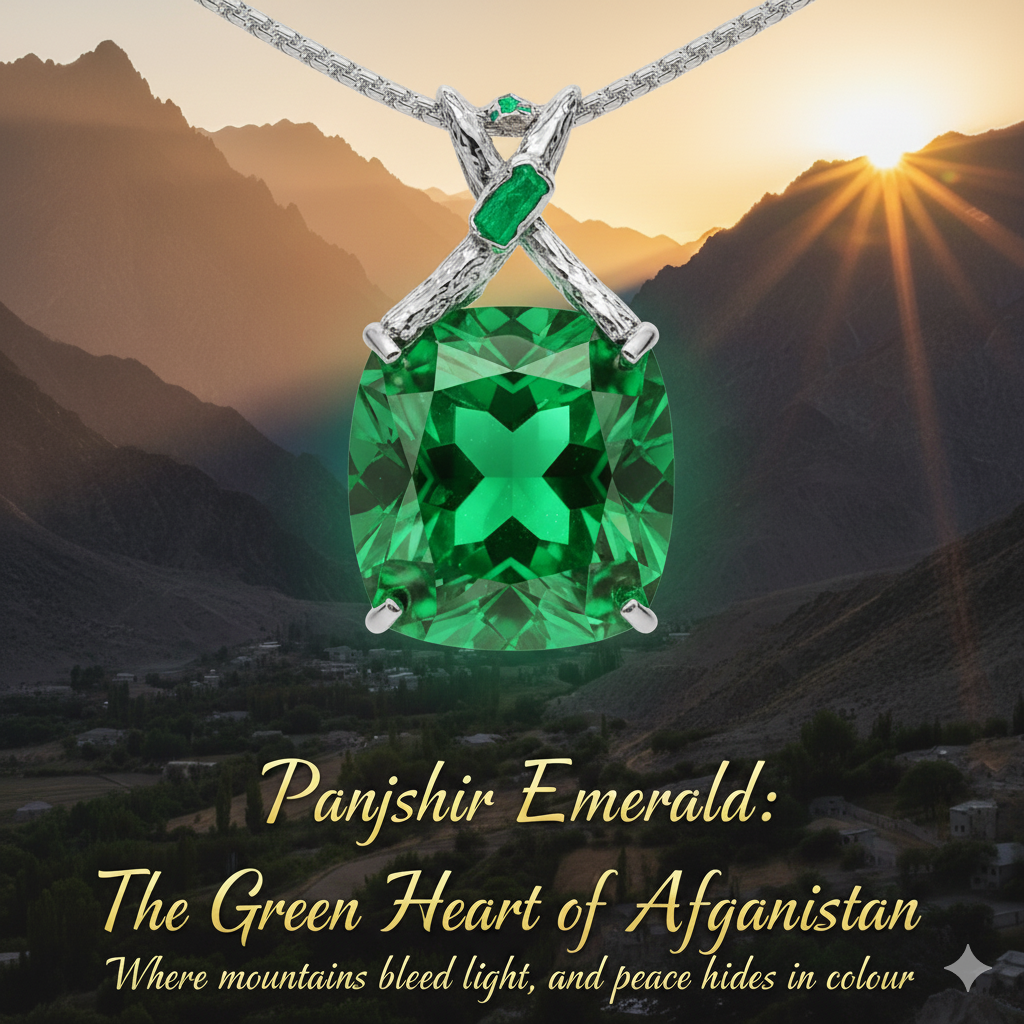Panjshir Emerald: The Green Heart of Afghanistan
Where mountains bleed light, and peace hides in colour.
1. In the Valley of Silence
High in the Hindu Kush, north of Kabul, lies the Panjshir Valley — a place where emeralds and history coexist in equal intensity.
Here, veins of green light run through marble and mica schist, visible only to those who risk the climb.
This narrow valley — 90 kilometers long, carved by the Panjshir River — has witnessed war, legend, and the quiet persistence of beauty. Amid conflict and hardship, it continues to produce emeralds so vivid, so lucid, that even in the rough, they seem already cut by the hand of God.
The world calls them Panjshir Emeralds — Afghanistan’s most precious gift to gemology, and perhaps its gentlest.
2. A Geography Written in Stone
The Panjshir Valley sits in Parwan Province, about 150 kilometers northeast of Kabul, surrounded by the snowcapped Hindu Kush range.
Geologically, it belongs to the Himalayan metamorphic belt, the same vast system that also hosts emeralds and other gems in Pakistan and Kashmir.
2.1 Formation
- Host rock: White marble and biotite schist
- Mineral: Beryl (Be₃Al₂Si₆O₁₈)
- Colouring agent: Chromium (Cr³⁺) with traces of vanadium
- Formation environment: Metasomatic reaction between beryllium-bearing pegmatite fluids and chromium-bearing ultramafic rock
- Age: Approximately 25–35 million years
2.2 Mining Altitude
Mines are perched between 3,000 and 4,000 meters, accessible only by mule tracks.
The terrain is brutal, the climate unforgiving — yet it’s here that nature forged some of the purest emeralds on earth.
3. A Colour Without Noise
Panjshir emeralds are immediately recognizable to trained eyes.
Their colour is intensely green, yet open, transparent, and free from the murkiness common in other origins.
| Property | Description |
|---|---|
| Hue | Pure green to slightly bluish-green |
| Tone | Medium to medium-dark |
| Saturation | High, vibrant, luminous |
| Transparency | Excellent (minimal oiling needed) |
| Inclusions | Three-phase inclusions (gas, liquid, crystal), mica flakes, tremolite needles |
When polished, they display Colombian-like luminosity — but often with stronger structure, slightly cooler undertones, and a clarity that feels more crystalline than silky.
Dealers often describe them as Colombian green seen through Himalayan air.
4. The Science of Light and Purity
Unlike Colombian emeralds, which form in black shale and carry “silky” inclusions that diffuse light, Panjshir emeralds form in marble — a low-iron host that yields extraordinary transparency.
This marble origin means:
- Less iron = less absorption = brighter internal glow.
- Stronger chromium concentration = intense colour without dark tone.
- Result: vivid, lively green that glows from within.
Under daylight, Panjshir emeralds often show a cooler, bluish cast, whereas Colombian stones lean toward warmer, yellow-green hues.
Both are beautiful, but Panjshir’s tone feels purer — like emerald water from a glacier-fed stream.
5. A History Written in Hardship
Though emeralds were known in Afghanistan since ancient times, systematic mining began only in the late 1970s, when Soviet geologists rediscovered old veins along the Panjshir River.
During the Soviet–Afghan War (1979–89), emeralds became both a source of funding for local resistance and a symbol of resilience.
Mining was entirely manual — hammers, chisels, candlelight.
Even today, much of it remains artisanal: family-run tunnels burrowed into marble cliffs, supported by hand-cut timbers.
The story of Panjshir emeralds is not just about beauty — it’s about defiance.
They are mined in silence, in defiance of time, war, and isolation. Each crystal is a victory over circumstance.
6. The Colour Wars: Colombia vs. Panjshir
For decades, Colombia’s Muzo and Chivor mines were considered unchallenged kings of green.
Then Panjshir emerged — quietly but powerfully — with material so fine that Colombian dealers began buying it, recutting it, and selling it as their own.
By the 1990s, gem labs like GRS, SSEF, and Gübelin began formally certifying Afghanistan (Panjshir) as a recognized emerald origin — a milestone that changed the gem trade forever.
6.1 Comparative Overview
| Feature | Panjshir (Afghanistan) | Muzo (Colombia) |
|---|---|---|
| Host Rock | Marble / Biotite Schist | Black Shale |
| Tone | Medium to medium-dark | Medium-dark |
| Colour Hue | Pure green to bluish-green | Slightly yellowish-green |
| Transparency | Exceptional | Very good |
| Inclusions | Mica, tremolite, 3-phase | “Jardin” veils, fluid feathers |
| Fluorescence | Strong red under UV | Moderate red |
| Treatment | Light oil only | Moderate oiling common |
| Overall Impression | Crystalline, bright, calm | Silky, lush, velvety |
Thus, while Colombia remains the romantic ideal, Panjshir now stands as its intellectual equal — more disciplined, less indulgent, but no less divine.
7. The Inclusions — Beauty Under the Microscope
Panjshir emeralds exhibit classic Type III clarity features, yet often cleaner than typical beryl of similar size.
Common inclusions include:
- 3-phase inclusions: gas + liquid + crystal (often halite or calcite).
- Mica flakes and tremolite needles: visible under 10x, giving a soft fibrous look.
- Fingerprint patterns: minor, graceful, rarely clouded.
These inclusions are natural — fingerprints of formation, not flaws. They remind collectors that perfection in nature is proof of authenticity.
8. The Rise of Panjshir in Global Markets
1980s–1990s: Discovery & Smuggling
Rough gems reached Peshawar and Karachi through informal routes, often mixed with Pakistani Swat material.
Dealers quickly recognized their superior quality.
2000s: Recognition
International labs began certifying Afghan origin.
High-end jewellers in Geneva and Hong Kong started sourcing directly through trusted intermediaries.
2020s: Maturity
Panjshir emeralds now appear regularly at Christie’s, Sotheby’s, and Bonhams, commanding prices approaching top Colombian stones.
9. Auction Milestones
- Christie’s Geneva 2021: 15.2 ct Panjshir emerald ring (unheated, un-oiled) — USD 1.8 million
- Sotheby’s New York 2022: 10.4 ct vivid bluish-green emerald, Afghan origin — USD 920,000
- Bonhams London 2024: 6.8 ct Panjshir emerald, AGL & SSEF certified — USD 480,000
At equal quality, Panjshir stones often fetch 70–90% of Colombian pricing, and rising steadily — a sign that connoisseurs are beginning to look beyond borders.
10. Ethical Dimensions
Unlike many global mining centers, Panjshir’s operations remain small-scale and human-powered.
There are no giant corporations, no open-pit mines, and little environmental destruction.
Challenges remain — lack of infrastructure, political uncertainty — yet these very conditions ensure that extraction remains limited and artisanal.
Every Panjshir emerald is, by nature, slow, ethical, and finite.
11. Treatment and Integrity
Panjshir emeralds are frequently lightly oiled, using traditional cedarwood oil or natural resins — a reversible, accepted standard in the gem world.
Because their clarity is naturally high, heavy treatments are rarely required.
Untreated specimens — “no oil” — are rare and prized at auctions, commanding 30–40% premium over oiled counterparts.
12. The Human Element
The miners of Panjshir are not corporate employees — they are villagers, fathers, sons.
They climb barefoot into tunnels with ropes, working under flickering lights for crystals that might change their lives — or not.
Local cooperatives often share profits, reinvesting in roads, schools, and electricity.
Thus, the Panjshir emerald carries not only geological beauty, but human dignity — a stone mined by those who have seen hardship, yet refuse to lose wonder.
13. Symbolism and Emotion
Emeralds have long symbolized renewal, balance, and vision.
In Islamic and Persian traditions, green is sacred — the colour of paradise and resurrection.
For Afghans, Panjshir’s emeralds carry an even deeper resonance: peace in permanence.
Every crystal that leaves the valley carries with it a fragment of the nation’s dream — to be known not for war, but for beauty.
14. Collectors and Connoisseurs
Modern collectors seek Panjshir emeralds for three reasons:
- Unheated, unenhanced rarity.
- Comparable quality to Colombian stones at lower price points.
- Provenance with moral weight — beauty from conflict’s shadow.
Elite jewellers — from Cartier to Sevva to Boghossian — now feature Panjshir emeralds in couture designs, acknowledging their growing reputation as the new Muzo.
15. The Future of the Valley
The mines continue to yield limited quantities — perhaps 30–40 kilograms of rough annually.
Yet, like Kashmir’s sapphire or Burma’s pigeon-blood ruby, production is not the metric of greatness — consistency of beauty is.
With renewed interest and cautious optimism, Panjshir may one day be to emeralds what Mogok is to rubies — a symbol of truth in colour.
16. PreciousCarats Reflection — The Colour of Courage
Panjshir emeralds are more than gemstones.
They are acts of defiance — proof that even the harshest landscapes can produce serenity.
Each one is a fragment of peace, a promise in green.
At PreciousCarats, we see in Panjshir the same grace we see in all true gems:
strength without hardness, purity without perfection, radiance born of endurance.
These are emeralds that have seen too much — yet glow as though nothing has ever hurt them.

